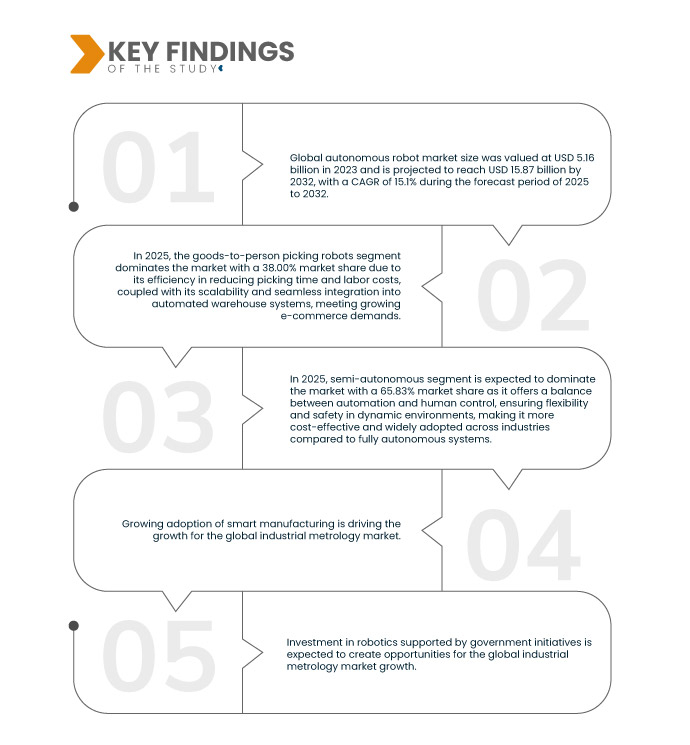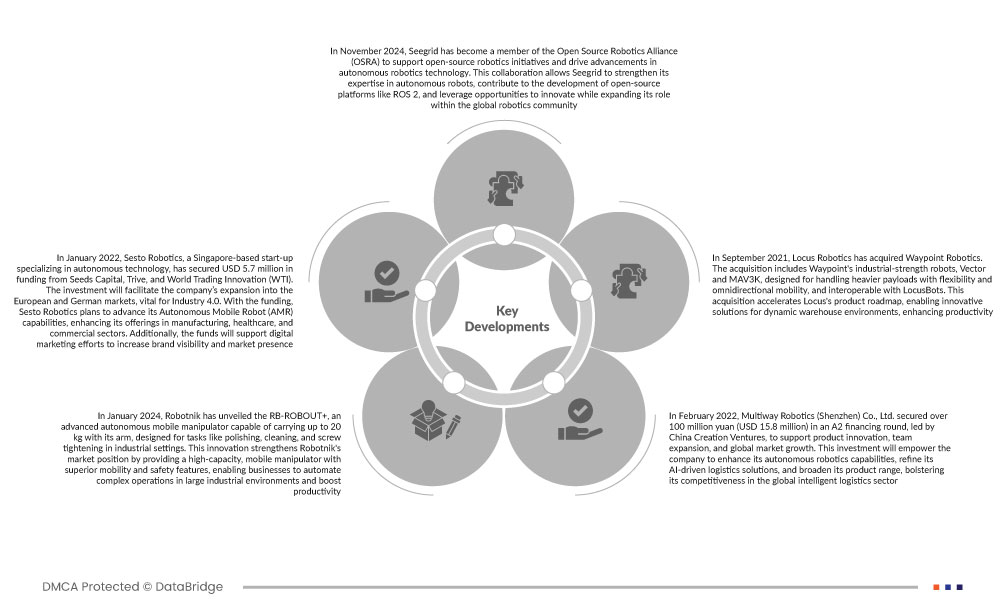يُسهم التبني المتزايد للتصنيع الذكي بشكل كبير في توسع سوق الروبوتات ذاتية التشغيل. ومع سعي الصناعات إلى تعزيز الكفاءة التشغيلية وخفض التكاليف وتحسين جودة المنتجات، يتزايد دمج الروبوتات ذاتية التشغيل في خطوط الإنتاج لمهام مثل مناولة المواد والتجميع والفحص. تُوفر هذه الروبوتات، المُجهزة بخوارزميات متقدمة للذكاء الاصطناعي والتعلم الآلي، معالجة فورية للبيانات، وقابلية للتكيف، ودقة عالية، مما يجعلها أساسية في بيئات التصنيع الحديثة. يُسرّع الطلب على الأتمتة، إلى جانب التطورات التكنولوجية في مجال الروبوتات، من نشر الروبوتات ذاتية التشغيل، مما يُساعد المُصنّعين على تلبية التوقعات المتزايدة لعمليات إنتاج أسرع وأكثر مرونة وفعالية من حيث التكلفة.
يمكنك الوصول إلى التقرير الكامل على https://www.databridgemarketresearch.com/reports/global-autonomous-robot-market
تشير تحليلات Data Bridge Market Research إلى أن حجم سوق الروبوتات المستقلة العالمية قُدِّر بـ 5.16 مليار دولار أمريكي في عام 2023 ومن المتوقع أن يصل إلى 15.87 مليار دولار أمريكي بحلول عام 2032، بمعدل نمو سنوي مركب قدره 15.1٪ خلال الفترة المتوقعة من 2025 إلى 2032.
النتائج الرئيسية للدراسة
تقنيات الاستشعار المحسنة والرؤية الحاسوبية
تُعدّ تقنيات الاستشعار المُحسّنة والرؤية الحاسوبية محوريةً في دفع عجلة نمو سوق الروبوتات ذاتية القيادة عالميًا. تُمكّن هذه التطورات الروبوتات من إدراك بيئاتها والتفاعل معها بدقة وكفاءة أكبر، مما يُحسّن مهام مثل الملاحة والتعرف على الأجسام وتجنب العوائق. ومن خلال دمج الكاميرات عالية الدقة، وأجهزة الليدار، وأجهزة استشعار الأشعة تحت الحمراء، والخوارزميات المتقدمة، يُمكن للروبوتات ذاتية القيادة العمل باستقلالية تامة في بيئات مُعقدة وديناميكية في مختلف الصناعات. ومع تطور أنظمة الاستشعار والرؤية، فإنها تُعزز دقة وموثوقية الروبوتات، مما يُؤدي إلى اعتمادها على نطاق أوسع في قطاعات التصنيع والخدمات اللوجستية والرعاية الصحية وغيرها، مما يُوسّع آفاق السوق.
نطاق التقرير وتقسيم السوق
مقياس التقرير
|
تفاصيل
|
فترة التنبؤ
|
من 2025 إلى 2032
|
سنة الأساس
|
2024
|
السنوات التاريخية
|
2023 (قابلة للتخصيص للفترة 2013-2017)
|
الوحدات الكمية
|
الإيرادات بالمليار دولار أمريكي
|
القطاعات المغطاة
|
حسب النوع (روبوتات التقاط البضائع من الشخص، والرافعات الشوكية ذاتية القيادة، والطائرات بدون طيار ، وروبوتات الجرد ذاتية التشغيل)، والعرض (الأجهزة، والبرامج، والخدمات)، وطريقة التشغيل (شبه ذاتية التشغيل ومستقلة بالكامل)، والتطبيق (إدارة أسطول المستودعات، والفرز، والالتقاط والوضع، والسحب، وغيرها)، والمستخدم النهائي (الصناعة والتصنيع، والتخزين والخدمات اللوجستية، والتجارة الإلكترونية، والرعاية الصحية، والزراعة، والجيش والدفاع، وغيرها)
|
الدول المغطاة
|
الولايات المتحدة الأمريكية، كندا، المكسيك، ألمانيا، المملكة المتحدة، فرنسا، إيطاليا، إسبانيا، روسيا، تركيا، هولندا، النرويج، فنلندا، الدنمارك، السويد، بولندا، سويسرا، بلجيكا، بقية أوروبا، الصين، اليابان، الهند، كوريا الجنوبية، أستراليا، إندونيسيا، تايلاند، ماليزيا، سنغافورة، الفلبين، نيوزيلندا، تايوان، فيتنام، بقية دول آسيا والمحيط الهادئ، البرازيل، الأرجنتين، بقية دول أمريكا الجنوبية، الإمارات العربية المتحدة، المملكة العربية السعودية، جنوب أفريقيا، مصر، إسرائيل، عُمان، البحرين، الكويت، قطر، وبقية دول الشرق الأوسط وأفريقيا
|
الجهات الفاعلة في السوق المغطاة
|
KUKA AG (ألمانيا)، Locus Robotics (الولايات المتحدة)، GreyOrange Inc. (الولايات المتحدة)، Harvest Automation (الولايات المتحدة)، ABB (سويسرا)، OMRON Corporation (اليابان)، Geekplus Technology Co., Ltd (الصين)، Multiway Robotics (Shenzhen) Co., Ltd. (الصين)، Teradyne Inc. (الولايات المتحدة)، Clearpath Robotics, Inc.، وهي شركة تابعة لشركة Rockwell Automation (كندا)، Zebra Technologies Corp. (الولايات المتحدة)، SESTO Robotics (سنغافورة)، Robotnik (إسبانيا)، Seegrid (الولايات المتحدة)، وAethon, Inc. (الولايات المتحدة) وغيرها.
|
نقاط البيانات التي يغطيها التقرير
|
بالإضافة إلى الرؤى حول سيناريوهات السوق مثل القيمة السوقية ومعدل النمو والتجزئة والتغطية الجغرافية واللاعبين الرئيسيين، تتضمن تقارير السوق التي تم تنظيمها بواسطة Data Bridge Market Research أيضًا تحليلًا متعمقًا من الخبراء والإنتاج والقدرة التمثيلية الجغرافية للشركة وتخطيطات الشبكة للموزعين والشركاء وتحليل اتجاهات الأسعار التفصيلية والمحدثة وتحليل العجز في سلسلة التوريد والطلب.
|
تحليل القطاعات
يتم تقسيم سوق الروبوتات المستقلة العالمية إلى خمسة قطاعات بارزة بناءً على النوع وطريقة التشغيل والعرض والتطبيق والمستخدم النهائي.
- على أساس النوع، يتم تقسيم سوق الروبوتات المستقلة العالمية إلى روبوتات التقاط البضائع من الشخص، والرافعات الشوكية ذاتية القيادة، والطائرات بدون طيار، وروبوتات المخزون المستقلة
في عام 2025، من المتوقع أن تهيمن شريحة روبوتات التقاط البضائع من الأشخاص على سوق الروبوتات المستقلة العالمية
في عام 2025، من المتوقع أن تهيمن شريحة روبوتات التقاط البضائع من الشخص على السوق بحصة سوقية تبلغ 38.00% بسبب كفاءتها في تقليل وقت التقاط البضائع وتكاليف العمالة، إلى جانب قابلية التوسع والتكامل السلس في أنظمة المستودعات الآلية، وتلبية متطلبات التجارة الإلكترونية المتزايدة.
- على أساس طريقة التشغيل، يتم تقسيم سوق الروبوتات المستقلة العالمية إلى شبه مستقلة ومستقلة بالكامل.
في عام 2025، من المتوقع أن يهيمن قطاع شبه المستقل على سوق الروبوتات المستقلة العالمية
ومن المتوقع أن تهيمن شريحة شبه المستقلة على السوق في عام 2025 بحصة سوقية تبلغ 65.83% لأنها توفر التوازن بين الأتمتة والتحكم البشري، مما يضمن المرونة والسلامة في البيئات الديناميكية، مما يجعلها أكثر فعالية من حيث التكلفة واعتمادًا على نطاق واسع في جميع الصناعات مقارنة بالأنظمة المستقلة بالكامل.
- بناءً على العرض، يُقسّم سوق الروبوتات المستقلة العالمي إلى أجهزة وبرامج وخدمات. في عام ٢٠٢٥، من المتوقع أن يهيمن قطاع الأجهزة على السوق بحصة سوقية تبلغ ٦٩.١١٪.
- بناءً على التطبيق، يُقسّم سوق الروبوتات المستقلة عالميًا إلى إدارة أساطيل المستودعات، والفرز، والالتقاط والوضع، والسحب، وغيرها. في عام 2025، من المتوقع أن يهيمن قطاع إدارة أساطيل المستودعات على السوق بحصة سوقية تبلغ 34.43%.
- بناءً على المستخدم النهائي، يُقسّم سوق الروبوتات المستقلة عالميًا إلى قطاعات الصناعة والتصنيع، والتخزين والخدمات اللوجستية، والتجارة الإلكترونية، والرعاية الصحية، والزراعة، والقطاع العسكري والدفاعي، وغيرها. ومن المتوقع أن يهيمن قطاع الصناعة والتصنيع على السوق بحصة سوقية تبلغ 39.10% في عام 2025.
اللاعبون الرئيسيون
قامت شركة Data Bridge Market Research بتحليل شركة KKUKA AG (ألمانيا)، وشركة ABB (سويسرا)، وشركة OMRON Corporation (اليابان)، وشركة Geekplus Technology Co., Ltd (الصين)، وشركة Teradyne Inc. (الولايات المتحدة) باعتبارها الشركات الرئيسية العاملة في سوق الروبوتات المستقلة العالمية.
تطورات السوق
- في نوفمبر 2024، انضمت شركة Seegrid إلى تحالف الروبوتات مفتوحة المصدر (OSRA) لدعم مبادرات الروبوتات مفتوحة المصدر ودفع عجلة التقدم في تكنولوجيا الروبوتات ذاتية التشغيل. يتيح هذا التعاون لشركة Seegrid تعزيز خبرتها في مجال الروبوتات ذاتية التشغيل، والمساهمة في تطوير منصات مفتوحة المصدر مثل ROS 2، والاستفادة من فرص الابتكار مع تعزيز دورها في مجتمع الروبوتات العالمي.
- في يناير 2022، حصلت شركة سيستو روبوتيكس، وهي شركة ناشئة مقرها سنغافورة متخصصة في تقنيات القيادة الذاتية، على تمويل بقيمة 5.7 مليون دولار أمريكي من سيدز كابيتال، وتريف، وورلد تريدينغ إنوفيشن (WTI). سيُسهّل هذا الاستثمار توسع الشركة في الأسواق الأوروبية والألمانية، وهو أمر حيوي للصناعة 4.0. وتخطط سيستو روبوتيكس، من خلال هذا التمويل، لتطوير قدراتها في مجال الروبوتات المتنقلة ذاتية القيادة (AMR)، وتعزيز عروضها في قطاعات التصنيع والرعاية الصحية والتجارة. كما سيدعم التمويل جهود التسويق الرقمي لتعزيز حضور العلامة التجارية وحضورها في السوق.
- في يناير 2024، كشفت شركة روبوتنيك عن روبوت RB-ROBOUT+، وهو جهاز تحكم متحرك متطور ذاتي الحركة، قادر على حمل ما يصل إلى 20 كجم بذراعه، وهو مصمم لمهام مثل التلميع والتنظيف وربط البراغي في البيئات الصناعية. يعزز هذا الابتكار مكانة روبوتنيك في السوق من خلال توفير جهاز تحكم متحرك عالي السعة يتميز بميزات تنقل وسلامة فائقة، مما يُمكّن الشركات من أتمتة العمليات المعقدة في البيئات الصناعية الكبيرة وتعزيز الإنتاجية.
- في فبراير 2022، حصلت شركة مولتي واي روبوتيكس (شنتشن) المحدودة على أكثر من 100 مليون يوان (15.8 مليون دولار أمريكي) في جولة تمويلية من الفئة A2، بقيادة شركة تشاينا كرييشن فينتشرز، لدعم ابتكار المنتجات وتوسيع فريق العمل ونمو السوق العالمية. سيُمكّن هذا الاستثمار الشركة من تعزيز قدراتها في مجال الروبوتات ذاتية التشغيل، وتحسين حلولها اللوجستية القائمة على الذكاء الاصطناعي، وتوسيع نطاق منتجاتها، مما يعزز قدرتها التنافسية في قطاع الخدمات اللوجستية الذكية العالمي.
- في سبتمبر 2021، استحوذت شركة لوكوس روبوتيكس على شركة واي بوينت روبوتيكس. يشمل هذا الاستحواذ روبوتات واي بوينت الصناعية القوية، Vector وMAV3K، المصممة للتعامل مع الحمولات الثقيلة بمرونة وتنقل متعدد الاتجاهات، والقابلة للتشغيل البيني مع روبوتات لوكوس. يُسرّع هذا الاستحواذ من تطوير منتجات لوكوس، مما يتيح حلولاً مبتكرة لبيئات المستودعات الديناميكية، ويعزز الإنتاجية.
التحليل الإقليمي
جغرافيًا، البلدان التي يغطيها تقرير سوق الروبوتات المستقلة العالمية هي الولايات المتحدة وكندا والمكسيك وألمانيا والمملكة المتحدة وفرنسا وإيطاليا وإسبانيا وروسيا وتركيا وهولندا والنرويج وفنلندا والدنمارك والسويد وبولندا وسويسرا وبلجيكا وبقية أوروبا والصين واليابان والهند وكوريا الجنوبية وأستراليا وإندونيسيا وتايلاند وماليزيا وسنغافورة والفلبين ونيوزيلندا وتايوان وفيتنام وبقية دول آسيا والمحيط الهادئ والبرازيل والأرجنتين وبقية دول أمريكا الجنوبية والإمارات العربية المتحدة والمملكة العربية السعودية وجنوب إفريقيا ومصر وإسرائيل وعمان والبحرين والكويت وقطر وبقية دول الشرق الأوسط وأفريقيا.
وفقًا لتحليل Data Bridge Market Research:
من المتوقع أن تصبح أمريكا الشمالية المنطقة المهيمنة في سوق الروبوتات المستقلة العالمية
بحلول عام 2025، ستهيمن أمريكا الشمالية على سوق الروبوتات ذاتية القيادة عالميًا بفضل تطوراتها التكنولوجية القوية واستثماراتها الكبيرة في الأتمتة في قطاعات مثل الخدمات اللوجستية والتجارة الإلكترونية والتصنيع. إضافةً إلى ذلك، فإن وجود شركات رائدة في السوق مثل بوسطن ديناميكس، وكليرباث روبوتيكس، وتيرادين، إلى جانب المبادرات الحكومية الداعمة للابتكار، يُسرّع من تبني هذه التقنيات في المنطقة.
من المتوقع أن تكون منطقة آسيا والمحيط الهادئ أسرع المناطق نموًا في سوق الروبوتات المستقلة العالمية
من المتوقع أن تقود منطقة آسيا والمحيط الهادئ سوق الروبوتات ذاتية التشغيل عالميًا. ويُعزى هذا النمو إلى عدة عوامل، منها التصنيع السريع، وتزايد اعتماد الأتمتة في مختلف القطاعات، والتركيز المتزايد على سلامة مكان العمل. وتستثمر دول مثل الصين والهند واليابان بشكل كبير في التكنولوجيا والبنية التحتية، مما يعزز الطلب على حلول السلامة المتقدمة.
لمزيد من المعلومات التفصيلية حول تقرير سوق الروبوتات المستقلة العالمية، انقر هنا - https://www.databridgemarketresearch.com/reports/global-autonomous-robot-market












